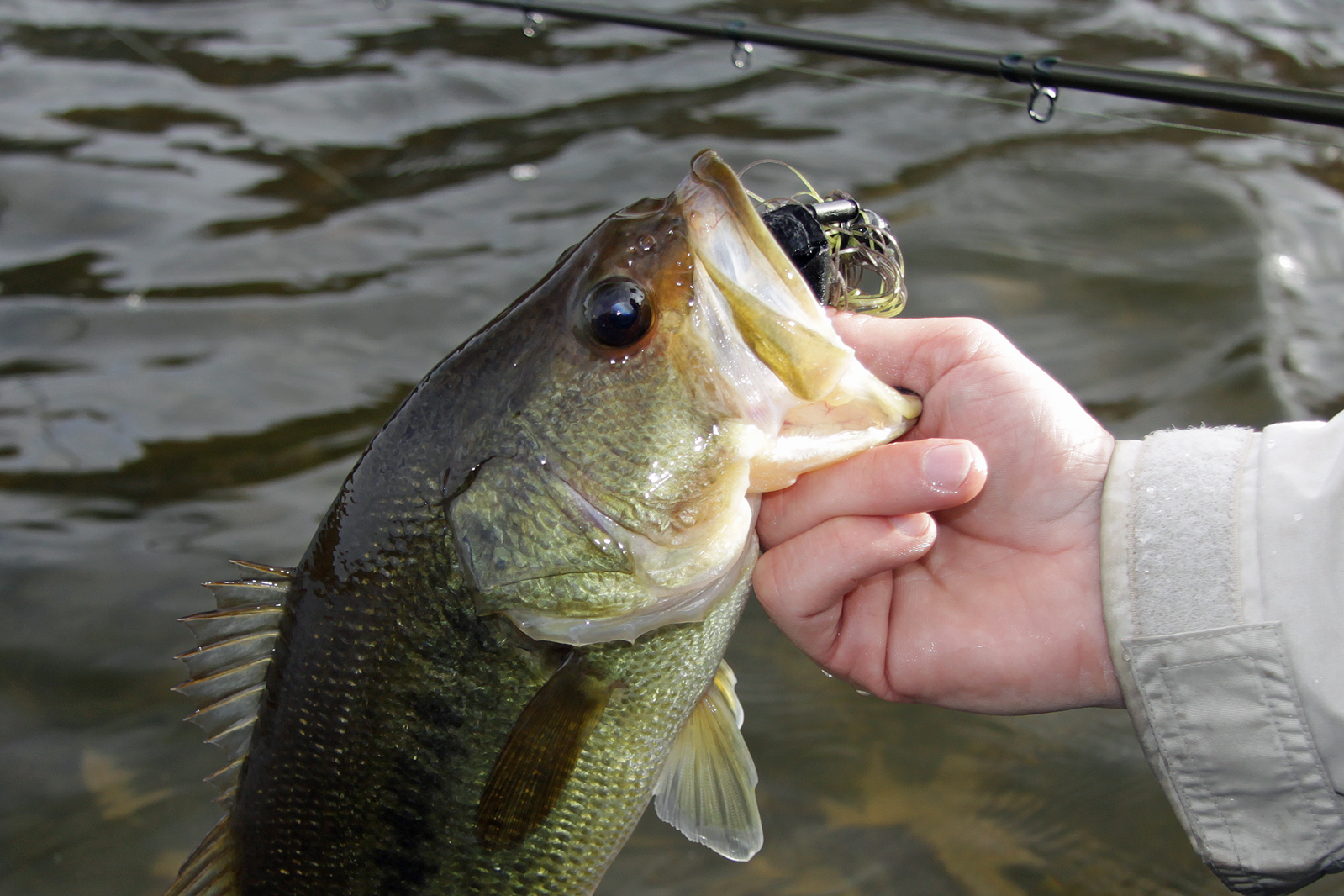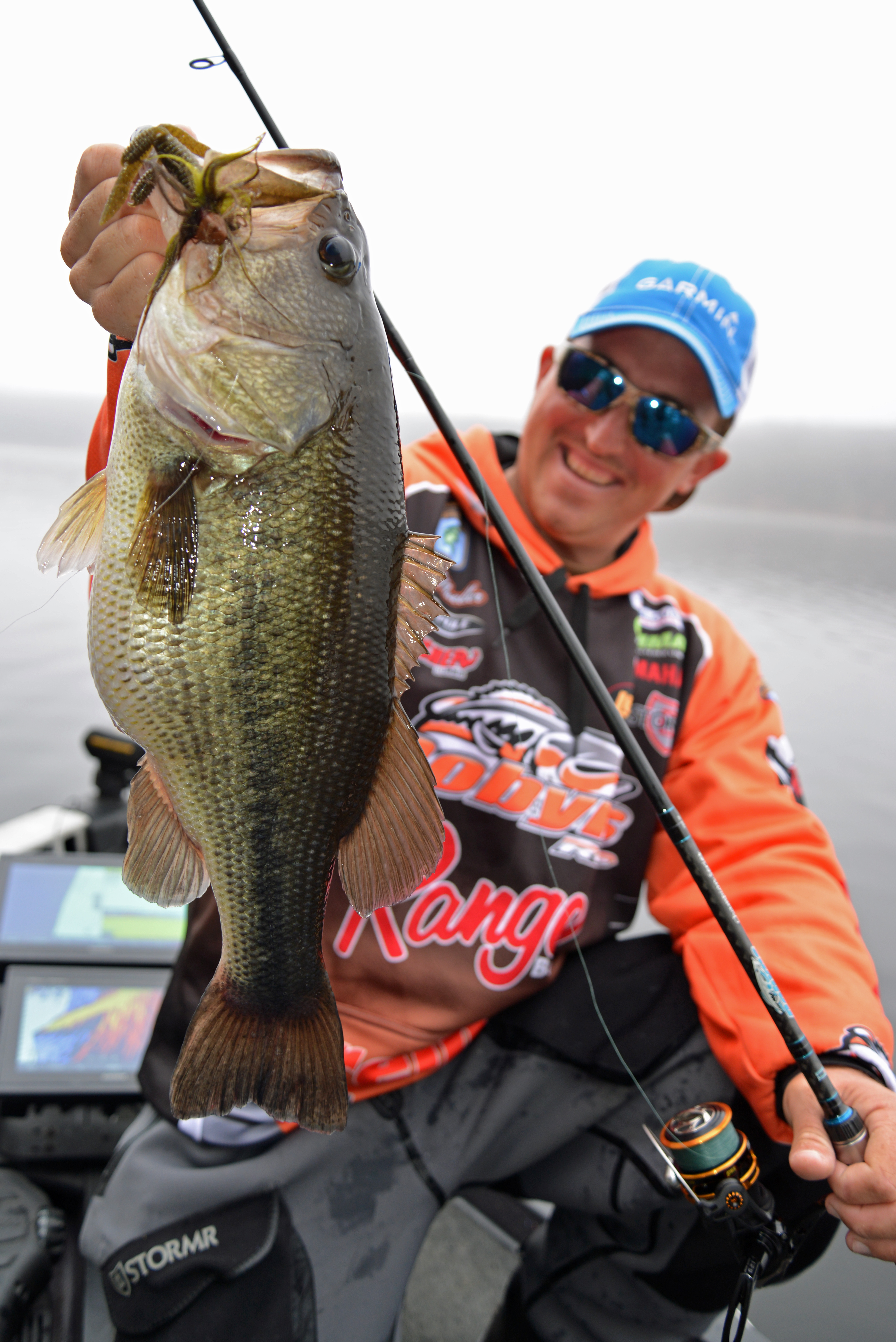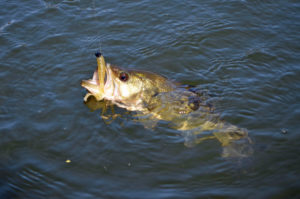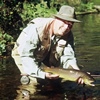DANCE A JIG FOR HOLIDAY BIGMOUTHS
By Tom Schlichter

Jig & pigs work well deep into the winter. Move out from the shore in cold, clear water and work these lures slowly and tight to the bottom. Photo by Tom Schlichter.
Serious freshwater anglers depend on a variety of jigs to separate bigmouth bass from weedy shallows during the summer. But will jigging produce once the salad recedes and the water turns crystal clear? You bet it will! With the mild falls and moderate winters we’ve experienced in recent years, many types of jigs can stay productive right through December and into the new year.
Keep ‘Em Swimming
As surface water temperatures make their way down below 50 degrees between Thanksgiving and Christmas, I’m particularly fond of tossing jigs across the deep end of slopes. I also like to work them tight to shore in areas that have three or four feet of water immediately adjacent to docks or tree trunks. Any remaining green growth is another target, as I’ve found bigger bass will hang around such clumps as long as even the tiniest bit of green is still visible on or just below the surface.

Connecticut bass pro Paul Mueller used a hair jig to catch and release this mid-December hawg. Photo courtesy of Paul Mueller.
For the most part, I’m still using my summer colors, styles and weights in the late fall and early winter months. That translates on most days to a 3/8-ounce black/blue Stanley Original jig tipped with a blue, black or red #11 Uncle Josh pork frog. With this, I’ll keep pounding the same general spots that worked all summer long but just a little further out from the bank where the water is slightly deeper. Rather than fish hard in the morning, I tailor my trips for afternoon sessions when the water is at its warmest. Fishing under heavy cloud cover also seems to help.
As the last of the weeds vanish in early December, I’ll sometimes reintroduce one of my favorite spring lures, the hair jig. These I’ll tip with a piece of red or yellow #50 Uncle Josh pork rind or a Fat Cow Jig Strip and swim along channel edges or near the tips of submerged tree branches in 4- to 6-foot depths.
Having a hair jig rigged and ready to go complements my standard jig & pig approach so that I can cover twice as much water by casting into the shallows with the hair jig and then working deeper water with the pig & jig off the other side of my kayak or john boat as I parallel the shore.
Small Is Good
Of course, there comes a point when the weeds are simply gone and the fish slow down as water temperatures continue to plummet. At that point, while everyone else is shopping for last-minute holiday gifts, I switch over to tiny football jigs or round jig heads tipped with 1- to 3-inch panfish-style grubs. These I can work on an ultralight, 4-pound class spinning outfit for both bass and panfish.
The key with using these small grubs is to fish deeper water over hard or sandy bottom if possible. I’ll let my offering settle to the bottom, give a light twitch or two, then let it set for four or five seconds before crawling it along the lake floor at a snail’s pace. Occasionally, I’ll give a light lift to raise the jig 4 or 5 inches above the bottom, then let it free-fall back, followed by another light twitch or two before repeating the whole process. In addition to tempting the bass, you’ll catch plenty of bluegill, pumpkinseed, white perch and yellow perch using this technique.
Interestingly, it is possible to separate the bass from the perch and panfish to a large degree using football jigs. If you keep the lure tight to the bottom at all times, you’ll mostly catch bass. Work in more lifts as opposed to twitches and drags, and you’ll find the panfish will inhale the jig as it is gliding upward. Oftentimes, the bass will be sulking underneath bluegills and pumpkinseeds. That being the case, I’ll often use the lifts first in any area I fish to find the panfish, then use the slow twitches to entice the bass I think are holding below. For the panfish, you’ll want to raise the lure 2 to 3 feet off the bottom at the top of each lift. For the bass, all lure movement should stay within a foot of the bottom.

This chunky bigmouth fell for a small soft-plastic grub on a lightweight jig head. Photo by Tom Schlichter.
Get A Late Start
One of the nicest things about late-season fishing it that you don’t need to get an early start. Instead of fishing at daybreak, be on the water at 9:00 a.m., 10:00 a.m. or in the early afternoon. This will give the water a little time to warm up and get the fish moving.
With that same thought in mind, you might think it a good idea to fish on bright sunny days but that logic just doesn’t hold up. While bass do like to hit during the warmest part of the day at this time of year, they also seem to hate prolonged periods of intense sunlight. Thus, look for days with rising temperatures accompanied by cloud cover to make your forays. Usually, that means winds from the west or southwest, which it turns out, are the most comfortable breezes for anglers, too.
By Tom Schlichter
Use the LIKE button below to get notifications about new articles in your Facebook news feed!



